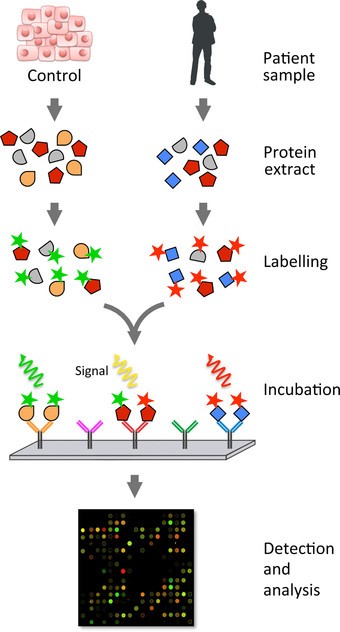Phospho Protein/Antibody Array
Protein phosphorylation plays an important role in cell signaling, development and growth processes. Among the protein signaling pathways, protein phosphorylation is the earliest understood and most intensively studied modification state. Regulation of phosphorylation produces a cascade amplification effect that is more effective, economical and rapid than regulation of protein expression levels and is an important tool for studying disease pathogenesis, drug effects and biological functions.
Phospho Protein/Antibody Arrays
From the cell membrane, cytoplasm to the nucleus, there are complex signaling networks formed by multiple signaling pathways. The signaling networks transmit signals into the cell through cascade amplification and decentralized regulation after extracellular stimulation, resulting in a series of integrated cellular responses. The emergence of a biological effect often involves the simultaneous activation of multiple signaling pathways, and the reversible phosphorylation modification is a common and energy-saving way to regulate the activation of signaling proteins within the cell. Therefore, finding the activated signaling pathways and even the phosphorylation-modulated pathway proteins is often the starting point of life science research.
These signaling proteins are widely involved in signaling of several important signaling pathways. For each specific protein phosphorylation site on the microarray, a pair of antibodies is set to detect its phosphorylation and non-phosphorylation status respectively to improve the sensitivity and stability of phosphorylation detection. The simultaneous screening of multiple signaling pathways and the clear localization of specific regulatory sites can be achieved in a single microarray experiment, which provides a clear direction for the subsequent in-depth exploration of biological phenomena.
Features of Phospho Protein/Antibody Arrays
- Design-specific chips for signaling pathways
- Phosphorylated and non-phosphorylated paired antibodies are available for each site
- Each antibody is set with duplicate sites to ensure the accuracy of experimental results
- Most phosphorylated microarrays can detect human, mouse, rat and other species
Application of Phospho Protein/Antibody Arrays
- Qualitative protein profiling
- Identify candidate biomarkers
- Key Factors Screening
- Biological Process Confirming
- Biomarker Validation
- Validation of Antibody Array Results
- Phosphorylation changes at specific sites
- Normal Range Establishing
- Compare profiles of normal diseased or treated samples
Our Phospho Protein/Antibody Arrays
Creative Proteomics has developed multiplex arrays for broad-scope protein phosphorylation profiling and screening in a single assay in cell and tissue samples. AKT, EGFR, MAPK, and RTK pathways available.
Signal Pathway Phosphorylated Antibody Microarray
Phosphorylation Profile Antibody Microarray
 Workflow of an analysis by antibody microarray
Workflow of an analysis by antibody microarray
References:
- YM Zhang, et al. A novel angiogenesis inhibitor impairs lovo cell survival via targeting against human VEGFR and its signaling pathway of phosphorylation. Cell Death and Disease (2012) 3, e406; doi: 10.1038/cddis.2012.145.
- Eke, et al. EGFR/JIP-4/JNK2 signaling attenuates Cetuximab-mediated radiosensitizationg of squamous cell carcinoma cells. Cancer Res. Published OnlineFirst October 16,2012; doi: 10.1158/0008-5472. CAN-12-2021.
- Clinical proteomics: Promises, challenges and limitations of affinity arrays.
* This product is For Research Use Only. Do Not use in diagnostic or therapeutic procedures.

 Workflow of an analysis by antibody microarray
Workflow of an analysis by antibody microarray